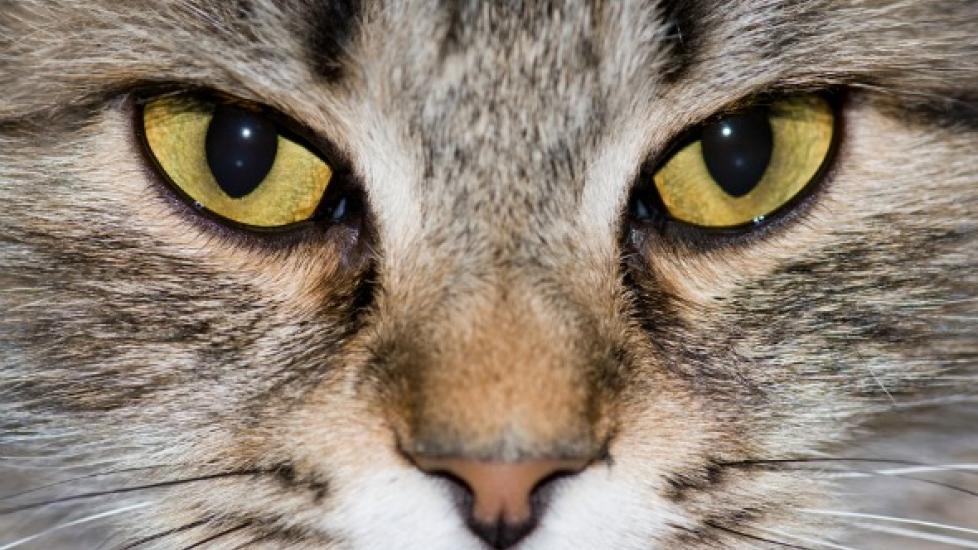Anisocoria in Cats (Cat Pupils Different Sizes)
Go to the emergency vet if you notice that one of your cat’s pupils is wider than the other.
What Is Anisocoria in Cats?
Anisocoria in cats is defined as a significant difference in the pupil size of each eye.
The function of pupils is to control the amount of light entering the eye. A cat’s pupils do this by getting wider or narrower in response to changes in the brightness of their environment.
When a cat’s pupils do not dilate or constrict appropriately, it can indicate a problem in one or both eyes. The abnormal eye may have either the smaller or bigger pupil, depending on the cause.
Can Anisocoria in Cats Be Fatal?
Although anisocoria itself is not fatal, nor even painful in most cases, the underlying cause is the more important issue. While dogs and people can develop “idiopathic” anisocoria, in which the pupils are occasionally different sizes for no reason at all, this is much rarer in cats. Therefore, if you notice your cat’s pupils are different sizes, even occasionally, a veterinary exam is important to uncover the cause.
Causes of Anisocoria in Cats
It is difficult to provide an exhaustive list of all the causes of mismatched pupil sizes in cats because there are so many. Here are some of the causes of anisocoria in cats:
-
Diseases inside and outside the eye can lead to anisocoria in cats.
-
Pupils can abnormally dilate due to conditions like glaucoma or damage to the retina in the back of the eye.
-
The pupil may also constrict inappropriately due to inflammation in the eye or painful conditions like corneal ulcers.
-
Neurologic disease can contribute to either dilated or constricted pupils in cats.
-
Eating certain toxic plants can cause one pupil to be larger than the other.
-
Certain viral, fungal, and parasitic infections can cause anisocoria in cats, and they are more common in cats that have access to the outdoors or were once strays.
-
Older cats are also more prone to cancer, and cancer within the eye can cause anisocoria in cats.
What to Do if Your Cat’s Pupils Are Different Sizes
Go to the emergency vet if you notice that one of your cat’s pupils is wider than the other.
Although chances are good that the underlying cause is not a true emergency, in this situation, it’s better safe than sorry. Some causes of anisocoria can progress rapidly, so it’s important to have your cat examined by a veterinarian as soon as you notice the abnormal pupil size.
Take pictures of your cat’s eyes in the abnormal state for the veterinarian, because occasionally, their eyes can go back to looking normal by the time a vet can examine them.
How Vets Diagnose the Cause of Anisocoria in Cats
Anisocoria is a symptom that can lead to the diagnosis of an underlying disease.
When a veterinarian examines a cat with anisocoria, they will carefully inspect both eyes, checking neurologic reflexes and looking for other abnormalities that may be too subtle to notice at home or with the naked eye.
Depending on the results of the physical exam, they may recommend bloodwork, including tests for organ function or certain infections. Imaging like X-rays and ultrasounds may also be useful in achieving a diagnosis that explains the anisocoria.
Treatment for Anisocoria in Cats
Because anisocoria is a symptom not a disease, the most important step in treating is first discovering the cause. The underlying causes of anisocoria in cats are just about countless—your cat may have pupils of different sizes for reasons ranging from infections to toxins to high blood pressure to cancer.
Many underlying causes of anisocoria can be managed, treated, and even cured with medication. Some infections may be treated with antibiotics or antifungals, while other infections, especially viral infections, are much more difficult to treat.
For causes like toxins or trauma, medications may serve a supportive role until time can heal the body. The most serious causes of anisocoria may respond only temporarily to medical intervention, if at all.
Recovery and Management of Anisocoria in Cats
If your cat exhibits anisocoria, it is impossible to predict how quickly (if ever) their eye will return to normal. If the underlying cause is treatable, then your cat’s pupils may return to their original, symmetric state.
In some cases, like ingestion of toxic plants, the symptom will gradually resolve on its own, and avoiding exposure to the plant will prevent the symptom from arising again.
If the underlying issue has to do with the eye itself, as with glaucoma or corneal ulcers, eye medications may be able to control the issue.
In other instances, ophthalmic surgery may be warranted.
In terminal conditions like cancer or widespread fungal disease, anisocoria is probably one of the least serious symptoms, so the other consequences of the underlying disease, especially pain, will take priority in the treatment plan.
FAQs
Is anisocoria in cats painful?
Anisocoria itself is not painful for cats. However, it is commonly seen in eyes that also have diseases that are painful, like glaucoma, corneal ulcers, and trauma.
Can anisocoria in cats go away on its own?
In certain cases, anisocoria will go away without treatment. However, because many of the underlying causes are serious and require quick intervention, you need to go to an emergency vet first. A veterinary exam will help determine how serious the situation is.
Is anisocoria dangerous in cats? Is it an emergency?
Because so many causes of anisocoria in cats are time-sensitive in their treatment and prognosis, take a trip to the emergency vet as soon as you notice that your cat’s pupils are different sizes.
Taking a “wait and see” approach may not always end in catastrophe, but it does come with its risks.


